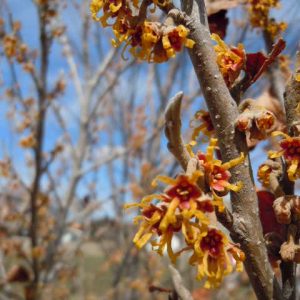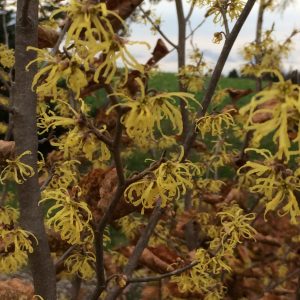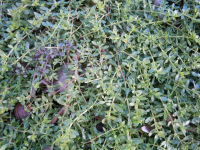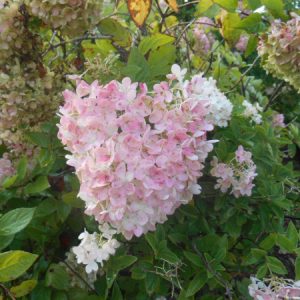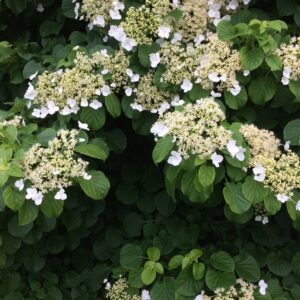Archives
Showing 89–96 of 199 results
-
Globularia trichosantha Blue Globe Daisy Z 5-9
Globe-shaped blue puffs bloom in late spring above a mat of evergreen foliage
ARCHIVED
Note: This is a plant not currently for sale. This is an archive page preserved for informational use.
Globe-shaped blue puffs bloom in late spring above a mat of evergreen foliage
Size: 6-8” x 8-12”
Care: sun to part shade in well-drained soil
Native: Balkan region of eastern Europe.
Wildlife Value: Attracts beesCollected before 1839.
-
Hamamelis vernalis Spring witch-hazel Z 4-8
Unusual, small yellow-red fragrant flowers in very early spring February-April. Showy golden foliage in fall. Hardy & durable.
ARCHIVED
Note: This is a plant not currently for sale. This is an archive page preserved for informational use.
Unusual, small yellow-red fragrant flowers in very early spring February-April. Showy golden foliage in fall. Hardy & durable.
Size: 6-10’ x spreading
Care: Sun to part shade in moist to moist well-drained acidic soil, tolerates clay. Prune in spring after flowering.
Native: Ozark Plateau of MO, OK & AK
Awards: Missouri Botanic Garden Plant of Merit.
Size: Native Americans made extracts of the leaves, bark and stems to remedy inflammation & bruises.Collected for horticulture by 1908.
-
Hamamelis virginiana Witch hazel Z 3-8
Oval shaped leaves turn shades of yellow in fall then stem-hugging clusters of sun-yellow ribbon-shaped petals cling to branches from October to December.
ARCHIVED
Note: This is a plant not currently for sale. This is an archive page preserved for informational use.
Oval shaped leaves turn shades of yellow in fall then stem-hugging clusters of sun-yellow ribbon-shaped petals cling to branches from October to December.
Size: 10-15’ x 10-15’, slow growth
Care: sun to part shade in moist well-drained soil to moist, acidic
Native: Novia Scotia to Florida, Great Lakes to east Texas, Wisconsin native
Wildlife Value: Attracts birds, Deer resistantAn extract of leaves, twigs, and bark is used in mildly astringent lotions and toilet water. A myth of witchcraft held that a forked branch of Witch-hazel could locate underground water. Native Americans used witch-hazel leaves for tea. Its oil used in medicines, eye-washes, after shave lotions and salves for soothing insect bites, burns and poison ivy rashes. Oneida used the leaves to remedy colds and stomach ailments. Illustrated in Catesby’s Natural History of Carolina, Florida and the Bahama Islands, published in series 1729-1747. Collected by French plant hunter André Michaux (1746-1802) who, for 11 years scoured eastern US as far west as the Mississippi River in Illinois Grown at America’s 1st botanic garden, Elgin Botanic Garden 1811.
-
Hernaria glabra Rupturewort Z 5-9
Tiny green flowers bloom atop tiny spreading foliage in July and August
ARCHIVED
Note: This is a plant not currently for sale. This is an archive page preserved for informational use.
Tiny green flowers bloom atop tiny spreading foliage in July and August.
Size: 2” x 12”
Care: sun moist well-drained to dry soil
Native: Europe, west & central AsiaGrown as a ground cover over graves in the 1800’s and “as a carpet bedding plant on account of its neat and compact dark green foliage,” Sanders 1913. Named for its old-time medicinal use, a remedy for hernias (powdered herb mixed with wine, ingested daily.)
-
Hosta nigrescens Black hosta, Kuro-Giboshi in Japan Z 3-8
Lavender blooms in August-September up to 6’ tall; nearly 3’ tall vase-shaped mound of thick, cupped foliage. Resists slugs.
ARCHIVED
Note: This is a plant not currently for sale. This is an archive page preserved for informational use.
Lavender blooms in August-September up to 6’ tall; nearly 3’ tall vase-shaped mound of thick, cupped foliage. Resists slugs.
Size: 32” (flowers to 6’) x 74”
Care: sun to shade in moist soil
Native: fertile soil in valleys and forest margins in central and north JapanWidely grown in Japanese temple gardens. Young leaves were eaten in Japan to ward off famine.
Cultivated long before it was given a botanical name by Maekawa (1937/1940). The Japanese name Kuro Gibōshi translates to “black hosta.” This name dates to the floral work of Yokusai Iinuma (1910). Not actually black, but very dark-green and covered with a light gray, powdery coating initially, the leaves lose the gray covering and become very dark, polished green. The species name nigrescens also describes the dark coloring.
-
Hosta plantaginea ‘Grandiflora’ syn. H. plantaginea var. japonica, Funkia grandiflora Z 3-9
Fragrant white trumpets in late summer and early autumn
ARCHIVED
Note: This is a plant not currently for sale. This is an archive page preserved for informational use.
Fragrant white trumpets in late summer and early autumn
Size: 24” x 36”
Care: part sun, moist well-drained soil
Native: China
Wildlife Value: attracts hummingbirds
Awards: Royal Horticultural Society Award of Merit.Hosta was named for Dr. Nicholas Host (1761 – 1834) physician to the emperor of Austria and expert on grasses. H. plantaginea was a popular Chinese plant as long ago as the Han Dynasty (202 B.C. – 220 A.D.) Chinese used an ointment made from H. plantaginea to reduce inflammation and fever. M. de Guines introduced H. plantaginea to Europe when he sent it to the king of France in 1789. Gertrude Jekyll, (1848-1931) mother of the mixed perennial border, recommended H. plantaginea ‘Grandiflora’ to keep border gardens looking “full and beautiful.”
-
Hydrangea paniculata ‘Grandiflora’ Pee-Gee hydrangea Z 4-8
In July and August, conical shaped heads, white fading to blush – spectacular.
ARCHIVED
Note: This is a plant not currently for sale. This is an archive page preserved for informational use.
In July and August, conical shaped heads, white fading to blush – spectacular.
Size: 4-5’ x 8’
Care: Moist to moist well-drained soil in full sun to part shade Prune: In late winter or early spring remove old inactive wood and last season's green growth. Cut back branches to control the height and spread of the shrub and create more dense growth. Cut old wood down to the crown of the plant and place all cuts on newer wood at the desired height, 1/4 inch above a leaf node or bud.
Native: Russia and Asia
Awards: Royal Horticultural Society Award of Merit.Hydrangea is Greek from hydor meaning water and aggeion meaning vessel referring to the cup shaped fruit. Von Siebold introduced H. paniculata from its native Japan in 1862. Five years later he introduced the variety ‘Grandiflora.’ The Wisconsin Horticultural Society recommended growing this in cemeteries and on lawns in 1896 – 1902.
-
Hydrangea petiolaris syn. Hydrangea anomala petiolaris Climbing hydrangea Z 4-8
Big white lacecap flowers blanket this climbing vine in early summer.
ARCHIVED
Note: This is a plant not currently for sale. This is an archive page preserved for informational use.
Big white lacecap flowers blanket this climbing vine in early summer.
Size: 40’ x 5-10’
Care: sun or shade in moist to moist well-drained soil
Native: Japan & Korea
Wildlife Value: Rich in nectar and pollen, its flowers attract bees, butterflies and more pollen-seeking insects.
Awards: Royal Horticultural Society Award of Garden MeritCollected by German physician and botanist Philipp Franz von Siebold in Japan during his residency on Nagaski working for the Dutch trading post there, 1823-1829. He introduced more than 2000 Japanese plants to Europe. 1st described in Flora Japonica 1839.


